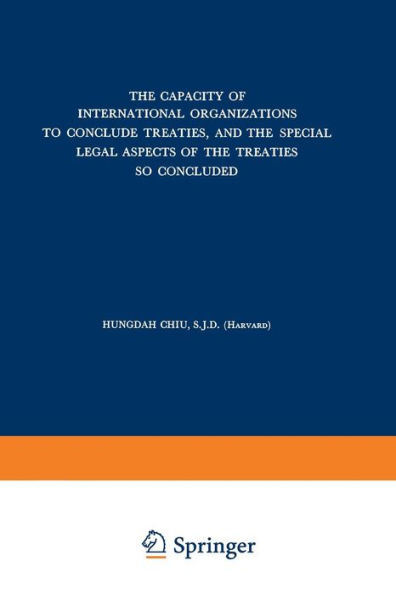The Capacity of International Organizations to Conclude Treaties, and the Special Legal Aspects of the Treaties so Concluded
Mter an international organization is established, if it is necessary for it to acquire certain rights or assume duties or new functions not provided in its constitution, there are four techniques to achieve that 1 end. The first is to amend the constitution of the organization. If the organization has only a limited number of members, then this technique is not too cumbersome. But, the procedure for amending a constitution is usually complicated and requires a substantial period of time. Thus this technique has at least the disadvantage of delay. 2 The second technique is to conclude a treaty among the member States of the organization. The organization is not a party to that treaty, but it can acquire some rights, assume some duties, or new functions under the treaty. 3 The disadvantage of this technique is similar to the first one, i. e. , the conclusion of a multilateral treaty may mean delay since the procedure involved is so complicated and cumber some. 1 E. g. , the Constitution of the ILO, Cmd. No. 393 (T. S. No. 4 of 1919), [1919] 13 Foreign ReI. U. S. : Paris Conf. 695 (1947), was amended on October 9, 1946,62 Stat. 3485, T. I. A. S. No. 1868, 15 U. N. T. S.
1120211102
The Capacity of International Organizations to Conclude Treaties, and the Special Legal Aspects of the Treaties so Concluded
Mter an international organization is established, if it is necessary for it to acquire certain rights or assume duties or new functions not provided in its constitution, there are four techniques to achieve that 1 end. The first is to amend the constitution of the organization. If the organization has only a limited number of members, then this technique is not too cumbersome. But, the procedure for amending a constitution is usually complicated and requires a substantial period of time. Thus this technique has at least the disadvantage of delay. 2 The second technique is to conclude a treaty among the member States of the organization. The organization is not a party to that treaty, but it can acquire some rights, assume some duties, or new functions under the treaty. 3 The disadvantage of this technique is similar to the first one, i. e. , the conclusion of a multilateral treaty may mean delay since the procedure involved is so complicated and cumber some. 1 E. g. , the Constitution of the ILO, Cmd. No. 393 (T. S. No. 4 of 1919), [1919] 13 Foreign ReI. U. S. : Paris Conf. 695 (1947), was amended on October 9, 1946,62 Stat. 3485, T. I. A. S. No. 1868, 15 U. N. T. S.
54.99
In Stock
5
1

The Capacity of International Organizations to Conclude Treaties, and the Special Legal Aspects of the Treaties so Concluded
225
The Capacity of International Organizations to Conclude Treaties, and the Special Legal Aspects of the Treaties so Concluded
225Paperback(Softcover reprint of the original 1st ed. 1966)
$54.99
54.99
In Stock

Product Details
| ISBN-13: | 9789024703173 |
|---|---|
| Publisher: | Springer Netherlands |
| Publication date: | 01/01/1971 |
| Edition description: | Softcover reprint of the original 1st ed. 1966 |
| Pages: | 225 |
| Product dimensions: | 6.10(w) x 9.25(h) x 0.02(d) |
From the B&N Reads Blog
